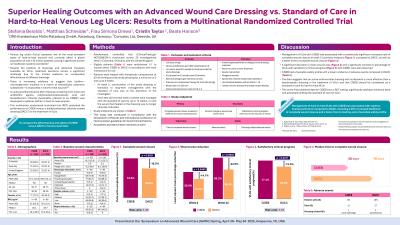Clinical Research
(CR-006) Superior Healing Outcomes with an Advanced Wound Care Dressing vs. Standard of Care in Hard-to-heal Venous Leg Ulcers: Results from a Multinational Randomized Controlled Trial
Friday, May 2, 2025
7:45 PM - 8:45 PM East Coast USA Time

Jan Ljungqvist, N/A – Convatec; Rebecca Rodger, BSc (Hons) – Convatec; Beate Hanson, MD, MPH – Convatec; Catarina Saavedra, MD – Instituto Nacional de Cancerología
Introduction: Venous leg ulcers (VLUs) represent one of the most prevalent types of hard-to-heal wounds and currently affect a global population of over 143 million patients, posing a significant burden on healthcare systems worldwide.1 VLU treatment remains challenging, with poor healing rates negatively impacting quality of life and limited clinical evidence for best treatment options. This multicenter randomized controlled trial (RCT) evaluated the performance of a carboxymethylcellulose dressing containing ionic silver, ethylenediaminetetraacetic acid and benzethonium chloride* (‘CISEB’) versus a dialkylcarbamoyl chloride-coated dressing (‘DACC')† in the treatment of VLUs.
Methods: This study was conducted in 2022 – 2024 across Germany, the United Kingdom, and Columbia. Subjects were randomized to either the interventional (CISEB) arm or the control (DACC) arm. Therapeutic compression and routine wound care were standardized management in both arms. Subjects returned to clinic for weekly follow-up. The primary endpoint was complete wound closure at 12 weeks. Additional endpoints included time to complete wound closure and incidence of adverse events (AEs).
Results: 203 subjects were randomized to CISEB (n=100) or DACC (n=103). Final analysis included 109 wounds in the interventional arm and 110 wounds in the control arm. Wounds treated with CISEB displayed significantly higher healing rates at 12 weeks than those treated with DACC (74.8% and 55.6%, respectively, superiority p-value < 0.0031). CISEB-treated wounds were 35% more likely to heal completely by 12 weeks than those treated by DACC [Relative Risk 1.35 (95% C.I., 1.10-1.65, non-inferiority p< 0.0001)]. Time to complete wound closure was shorter in CISEB-treated wounds compared to DACC (median 56 and 70 days, respectively, p< 0.0272). 11 AEs in 5/101 (4.95%) subjects from CISEB arm were recorded with 27 AEs in 18/102 (17.65%) subjects from the DACC arm.
Discussion: In this multinational, multicenter RCT, hard-to-heal VLUs treated with CISEB were found to achieve superior clinical outcomes with significantly higher healing rates, shorter time to wound closure, and fewer AEs compared to those treated with DACC.
Methods: This study was conducted in 2022 – 2024 across Germany, the United Kingdom, and Columbia. Subjects were randomized to either the interventional (CISEB) arm or the control (DACC) arm. Therapeutic compression and routine wound care were standardized management in both arms. Subjects returned to clinic for weekly follow-up. The primary endpoint was complete wound closure at 12 weeks. Additional endpoints included time to complete wound closure and incidence of adverse events (AEs).
Results: 203 subjects were randomized to CISEB (n=100) or DACC (n=103). Final analysis included 109 wounds in the interventional arm and 110 wounds in the control arm. Wounds treated with CISEB displayed significantly higher healing rates at 12 weeks than those treated with DACC (74.8% and 55.6%, respectively, superiority p-value < 0.0031). CISEB-treated wounds were 35% more likely to heal completely by 12 weeks than those treated by DACC [Relative Risk 1.35 (95% C.I., 1.10-1.65, non-inferiority p< 0.0001)]. Time to complete wound closure was shorter in CISEB-treated wounds compared to DACC (median 56 and 70 days, respectively, p< 0.0272). 11 AEs in 5/101 (4.95%) subjects from CISEB arm were recorded with 27 AEs in 18/102 (17.65%) subjects from the DACC arm.
Discussion: In this multinational, multicenter RCT, hard-to-heal VLUs treated with CISEB were found to achieve superior clinical outcomes with significantly higher healing rates, shorter time to wound closure, and fewer AEs compared to those treated with DACC.

.jpg)